Another week of the daily posts on Hull Photos of images I made in the 1980s. You can see the new pictures every day on the main menu page, but it’s better to follow my posts on Facebook, where you will also see the comments I make on the pictures, and can comment on them.
Comments on the pictures are also welcome here.
15th September 2017
Taken on Wincolmee just a few yards south of the junction with Green Lane and Lincoln St this image incorporates the reflection in the window, the machinery – I think for sale – within and also a view out through the window around the side. This building is still there but the side window has been bricked up.
But most of the view is straightforward and past the roundabout shows the buildings at the junction of Lincoln St and Wincolmlee, looking roughly north. These are still recognisable, and the Whalebone Inn is still open though it has lost the hanging sign and is under different ownership. The site at the right, with a notice for a seed crushing company is now empty.
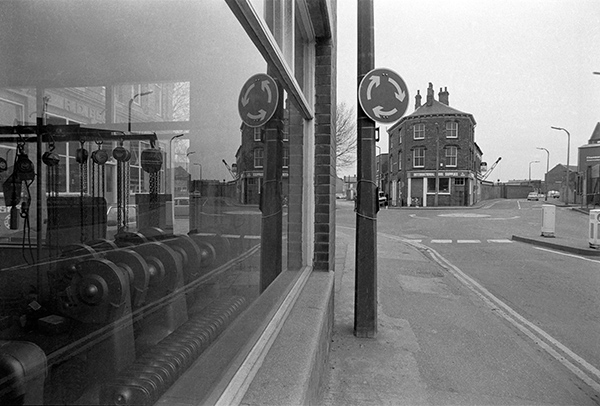
84-4k-51: Wincolmlee, Green Lane, Lincoln St roundabout, 1984 – River Hull
16th September 2017
This structure, I think a large panel in front of a bulk oil storage tanks, at one of the wharves on Wincolmlee fascinated me and I photographed it on several occasions, both in black and white and in colour.
The way the different panels caught the light and their diamond shapes, the vertical ladder with its horizontal rungs and the various rectangular and circular accents all seduced my attention.
But I do have a nagging feeling that this is perhaps more of a design exercise than a real photograph of Hull.
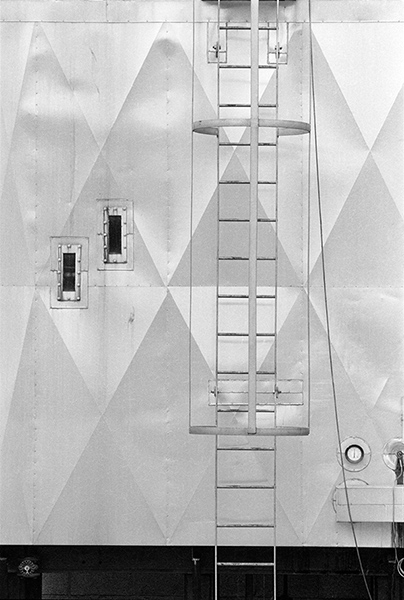
84-4k-52: Wincolmlee, 1984 – River Hull
17th September 2017
Conveniently both street names are visible in this view take from just inside St Mary’s Burial Ground, on the corner of Air St and Bankside.
Sculcoates by the 1820s had grown from from a population of around a hundred to over 10,000 and the old St Mary Sculcoates which had existed since 1232 or earlier was replaced in 1760 by “a very handsome structure, with a square tower of white brick and Roche Abbey stone, in the pointed style of the time of Henry IV” with seating for 1300 people on the corner of Air St and Bankside. You can see it in a print on the Hull Museums site.
The two pillars in this picture are the lower parts of the gate posts of the 1760 church which was ‘improved’ in 1875 at a cost of £1000 and then demolished in 1916. A new St Mary Sculcoates was built a few hundred yards to the west on Sculcoates lane and is still in use. That church is open on Heritage Open days, but all that remains of the 1760 church are the gateposts (cut off rather shorter – perhaps the upper parts taken for incorporation in the new church, as apparently were the columns) and a little of the wall on which the railings once stood, and the burial ground. There are roughly 50 graves and monuments although inscriptions are only legible on around 20 of them, the most recent dating from the 1850s.
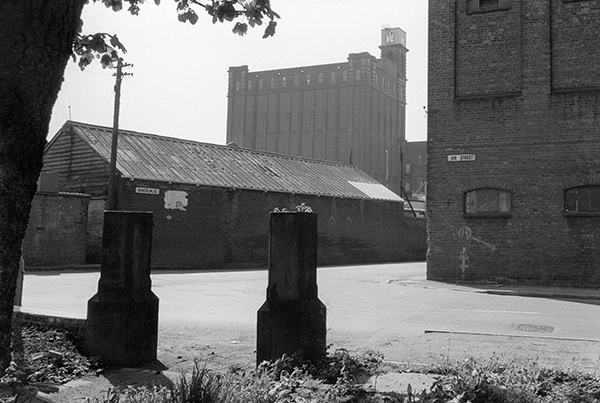
85-5f-11: Air St and Wincolmlee, 1985 – River Hull
18th September 2017
Taken just a few feet from the previous image, this shows the corner of St Mary’s Burial Ground at the junction of Air St and Bankside. The earth here appears to have recently been cleared, and is now rather more overgrown.
At the extreme right is one of the truncated posts of the gate that led into the churchyard, and to the left of that two slimmer posts, one for a street light and the other for the road sign. The shadow of this latter amused me by adding a cross to the churchyard.
Across Bankside, a wall with a gate is of one of the wharves on the west bank of the River Hull, now disused and empty, part of a long riverside site for Seatons. The company John L Seaton & Co Ltd, was founded by John Love Seaton (1820–1903), born in Chatham, Kent, who became an alderman and mayor of Hull in 1873-74. His Mayoral portrait in the Guildhall by Ernest Gustave Girardot is one of the better examples of the genre. Its main business was in crushing rape seed to extract the oil, then known as colza oil.
Colza was widely used in oil lamps to provide light, with the residue after extraction becoming animal feed. The first lighting installed in railway carriages was provide by colza, but was later replaced by gas – and then electricity. Perhaps more importantly for Hull, this was the oil used to calm troubled waters and was carried in all ship’s lifeboats for this purpose. It was also widely used as a lubricant, and is now extracted mainly for use as bio-diesel, particularly in Germany. Different varieties of rape are grown for the rapeseed oil now widely used in cooking.
The business obviously did well, with Alderman Seaton leaving over £50,000 in his will. The company amalgamated with others over the years developing a wide range of vegetable oils and oil-related products and in 1970 was acquired by Croda International. Production at its site in Hull continued until 2002 and for some years after this it had offices in Hessle, but is now simply a trade name used by Croda.
The buildings whose triangular gables are visible are on the far side of the river and are an Enterprise Zone, part of the River Hull Heartlands Foster St development site.The site was once a brickworks and is privately owned.
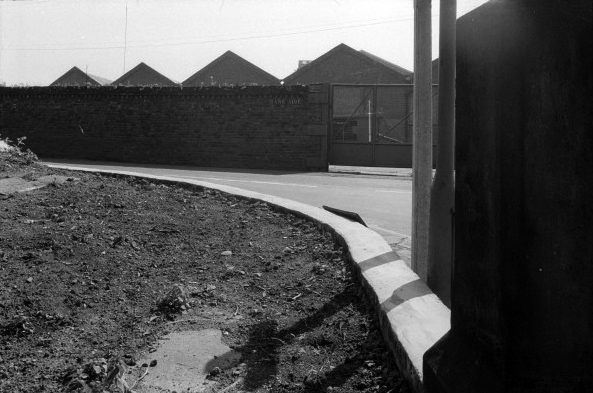
85-5f-14: Air St and Bankside, 1985 – River Hull
19th September 2017
Taken near to the corner of Air St and Bankside, but nothing in the image enables me to identify the exact location, though I think it is probably at a corner of the site of John L Seaton & Co Ltd.
I made two exposures from exactly the same position, this and another in portrait format, which shows the metal chimney to have been rather tall, and it is possibly on the site of Holmes Hall’s Sculcoates Tannery on the south side of Air St. The fixed viewpoint suggests to me it could have been taken with the lens poked through a fence or gate.
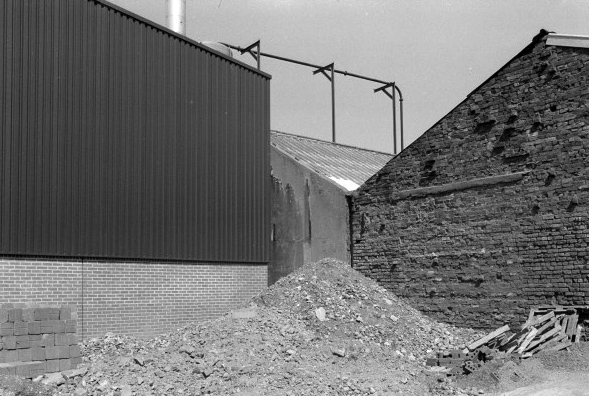
85-5f-15: Air St area, 1985 – River Hull
20th September 2017
Steam issuing from a pipe at the top left confirms that the North Works of John L Seaton & Co Ltd on Air St was still at work. This rather handsome brick building was perhaps rather suprisingly still there when I last looked, as were the pipes bridging the road, although the name board is long gone, presumably removed when production there ceased in 2002 if not before.
Beyond Seaton’s North Works the picture shows (just) the Golden Ball pub and I think some further buildings which I seem to remember included a small shop selling sweets and cigarettes. Air St is the eastern end of Sculcoates Lane and was probably built around 1800, and the Golden Ball probably dated from about then (there is a detailed discussion on Paul Gibson’s site (http://www.paul-gibson.com/pubs-and-breweries/air-street-pubs.php) and was definitely a pub by 1810, though extended and altered later. It was listed as the Blue Ball in 1823, but changed its name to the Golden Ball around 1882. There were further alterations in the 20th century, but as the factories around closed, trade dropped off in the 1970s and 80s, and the pub was demolished in 1996 when Seaton’s wanted more storage space. Only six years later they ended work on the site.
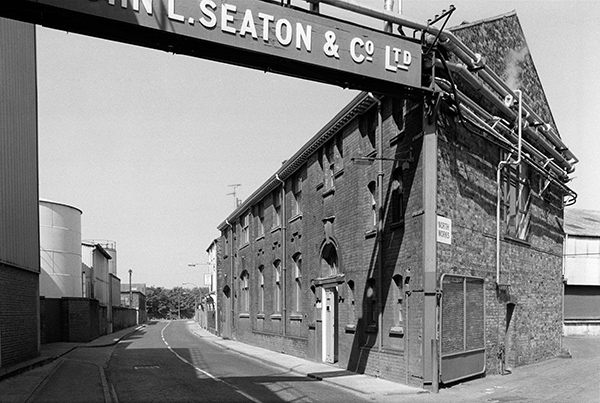
85-5f-44: John L Seaton & Co Ltd, Air St, 1985 – River Hull
21st September 2017
Thanks to comments on-line I can now be sure that this picture is of Victoria Terrace, off Stepney Lane and shows the Grade II listed chimney of Beverley Rd Baths. Unfortunately this appears to have been demolished. There is a chimney somewhere near, but it is a plain brick affair. The listing text for Beverley Rd Baths describes the chimney as “At the rear, a tall panelled chimney stack, formerly with a decorative cap.”
One of my wife’s great aunts, Florrie Needley, kept a small corner shop on Stepney Lane close to here that I visited back in the 1960s, I think on one of the corners of this terrace. I remember it as selling sweets, but I think it also sold other foods, and some wives in the area would bring in the money their husbands gave to them after they were paid for safe-keeping, as they were afraid that after having drunk the cash they had kept back their husbands would take it back from them.
This terrace was clearly still inhabited in 1985, with washing hanging out and windows open, but has almost certainly been demolished since. The boat has number 497 and I can read the word ‘TRINITY’ but what follows is impossible to make out. The front yards on the opposite side of the terrace are slightly wider and opposite the boat but just out of frame was a small caravan in one of them, though it was hard to see how it could ever be moved out.
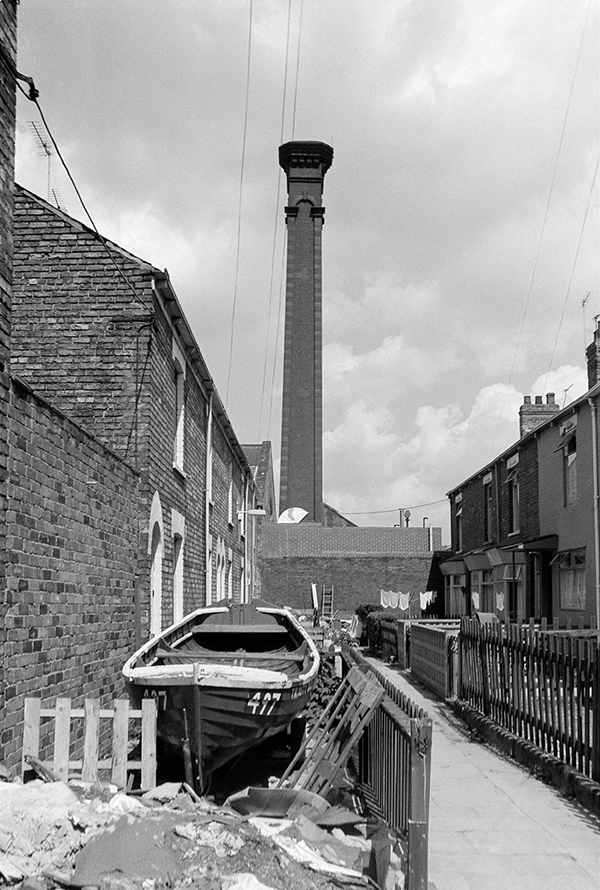
85-5g-22: Terrace with boat, Victoria Terrace, Stepney Lane, 1985 – Beverley Rd
You can see the new pictures added each day at Hull Photos, and I post them with the short comments above on Facebook.
Comments and corrections to captions are welcome here or on Facebook.
______________________________________________________
There are no adverts on this site and it receives no sponsorship, and I like to keep it that way. But it does take a considerable amount of my time and thought, and if you enjoy reading it, a small donation – perhaps the cost of a beer – would be appreciated.
My London Diary : Buildings of London : River Lea/Lee Valley : London’s Industrial Heritage
All photographs on this and my other sites, unless otherwise stated, are taken by and copyright of Peter Marshall, and are available for reproduction or can be bought as prints.